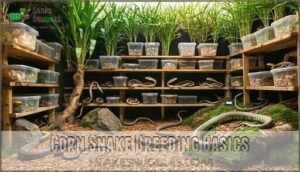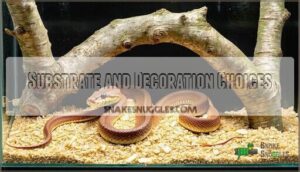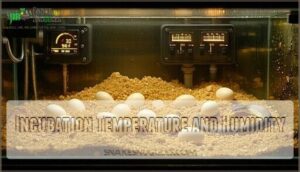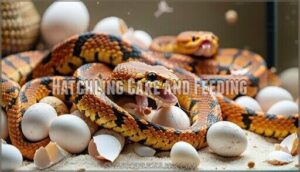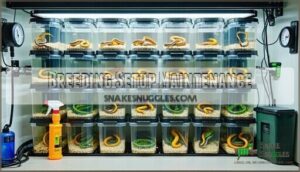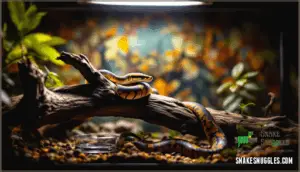This site is supported by our readers. We may earn a commission, at no cost to you, if you purchase through links.
 You’ll need proper corn snake breeding setup requirements including separate 40-gallon enclosures for each breeding pair, precise temperature control with 78-85°F gradients, and dedicated incubation equipment.
You’ll need proper corn snake breeding setup requirements including separate 40-gallon enclosures for each breeding pair, precise temperature control with 78-85°F gradients, and dedicated incubation equipment.
Your setup requires thermostats, under-tank heaters, cypress mulch substrate, multiple hide boxes, and proper ventilation.
Breeding snakes need 18-24 months maturity, quarantine protocols, and humidity maintained at 50-60% for adults, 75-85% for incubating eggs.
Don’t forget backup power systems and detailed record-keeping logs.
The real secret lies in understanding seasonal cycling and the subtle environmental triggers that spark successful breeding behavior, which involves proper ventilation.
Table Of Contents
- Key Takeaways
- Corn Snake Breeding Basics
- Snake Enclosure Requirements
- Breeding Pair Selection
- Egg Incubation and Care
- Breeding Setup Maintenance
- Frequently Asked Questions (FAQs)
- How hard is it to breed corn snakes?
- What set up does a corn snake need?
- How long after breeding do corn snakes lay eggs?
- What is the biggest trouble with corn snakes as pets?
- What breeding frequency prevents snake health issues?
- How long should post-breeding recovery periods last?
- What backup power solutions protect incubation equipment?
- How do seasonal light cycles affect breeding?
- Conclusion
Key Takeaways
- You’ll need separate 40-gallon enclosures with precise temperature control (78-85°F gradients) and dedicated incubation equipment, including thermostats, under-tank heaters, and proper ventilation systems.
- Select breeding pairs carefully by choosing healthy adults that are 18-24 months old, weigh at least 250-300g (females) or 200g+ (males), and have documented genetic histories to avoid inbreeding issues.
- Maintain optimal environmental conditions with humidity at 50-60% for adults and 75-85% during egg incubation, plus seasonal light cycling to trigger natural breeding behaviors.
- Implement comprehensive monitoring systems including backup power for incubators, detailed breeding logs, quarantine protocols, and regular veterinary checkups to prevent disease outbreaks.
Corn Snake Breeding Basics
Starting a corn snake breeding project requires careful preparation and the right foundation stock.
You’ll need to select healthy adult snakes that meet specific criteria for age, size, and genetic compatibility to guarantee successful reproduction and viable offspring. Complete concepts and separate lines.
Choosing Healthy Snakes
You’ll need healthy foundation stock for successful corn snake breeding. Start with a thorough physical examination, checking for mites, retained sheds, and respiratory issues.
Establish a quarantine protocol before introducing new snakes.
Essential health screening steps:
- Vet checkup – Complete examination including fecal testing for parasites
- Genetic history review – Document lineage and previous breeding records
- Behavioral signs assessment – Monitor feeding response and activity levels
Look for clear eyes, smooth scales, and consistent feeding habits. Avoid snakes with kinked spines, neurological issues, or poor body condition.
Document everything thoroughly for future reference.
Genetic Diversity Importance
Genetic diversity forms the backbone of successful corn snake breeding, preventing inbreeding depression that causes deformities and reduced clutch viability.
Outcrossing promotes hybrid vigor, creating healthier offspring with stronger immune systems. Smart breeders maintain gene flow between bloodlines, avoiding the genetic bottlenecks that plague closed populations.
Strong genetics build better snakes—outcrossing beats pretty morphs every time.
Your breeding program’s longevity depends on embracing conservation genetics principles over short-term morph profits. Understanding inheritance patterns is essential for predicting offspring traits.
Breeding Age and Size
Your breeding snakes should reach minimum weight thresholds before attempting reproduction.
Healthy breeding stock requires proper weight—never rush reproductive timelines for quick profits.
Female corn snakes need at least 250-300 grams, while males require 200+ grams for successful snake breeding setup**.
Maturity signs include age 18-24 months and proper body condition.
Size correlation directly impacts clutch frequency and egg production success.
Healthy breeding lifespan extends 10-15 years with proper corn snake care and reptile breeding protocols in your breeding enclosure.
Sexing Corn Snakes
Once you’ve confirmed your snakes have reached sexual maturity, you’ll need to determine their sex accurately.
Visual sexing works by examining tail thickness and length – males typically have longer, thicker tails.
The popping technique reveals hemipenes in males but requires breeder experience to avoid probing risks.
Many reptile breeding enthusiasts prefer professional sexing services for their snake breeding setup.
Proper identification prevents costly mistakes in your corn snake care program.
Snake Enclosure Requirements
Creating the perfect breeding environment starts with proper enclosure setup that meets your snakes’ specific needs.
You’ll need adequate space, proper ventilation, precise temperature control, and suitable substrate choices to guarantee successful breeding and healthy offspring, which involves proper ventilation and precise temperature control.
Space and Ventilation Needs
Adult corn snakes require enclosures measuring at least 40 gallons, though breeding pairs benefit from larger spaces.
Proper airflow design prevents stagnant air while maintaining stable humidity levels, and cross-ventilation using screened tops and side vents optimizes space utilization.
Ventilation methods should balance fresh air circulation with breeding temperature requirements, ensuring your snake husbandry setup supports healthy reproduction without compromising environmental stability, and this balance is crucial for healthy reproduction.
Temperature and Humidity Control
Proper temperature and humidity control prevents breeding failures and keeps your snakes healthy year-round.
You’ll need heating gradients from 75-85°F, with breeding temperatures slightly cooler during winter cooling periods.
Maintain humidity levels between 50-60% using monitoring equipment and regular thermostat calibration.
Make seasonal adjustments to simulate natural cycles that trigger breeding behaviors in your corn snakes, ensuring a healthy environment through proper temperature control.
Lighting and Heating Options
Lighting systems form the backbone of successful breeding programs, creating natural rhythms that trigger reproductive behaviors.
You’ll need multiple components working together to maintain proper temperature gradients and light cycles for ideal snake health.
While not strictly necessary, some keepers find that low-level UV exposure can be beneficial.
- Heat mats – Under-tank heating panels controlled by thermostats for consistent ground warmth
- Ceramic heaters – Overhead heat sources providing ambient temperature without light emission
- UVB lighting – Low-intensity T5 bulbs supporting vitamin D3 synthesis and calcium absorption
- Full-spectrum LEDs – Daylight simulation maintaining 12-hour light cycles for circadian rhythm regulation
- Halogen flood bulbs – Basking spotlights creating precise temperature gradients essential for thermoregulation
Substrate and Decoration Choices
Several safe substrates work perfectly for breeding setups, with aspen shavings and cypress mulch leading the pack for humidity control.
You’ll need multiple hiding spots on both warm and cool sides, plus visual barriers to reduce stress during egg incubation periods.
Add climbing branches for enrichment, but keep decorations minimal—cluttered enclosures complicate hatchling care and cleaning your breeding substrate effectively.
Many breeders prefer using aspen bedding for their breeding setups, as it provides a safe and healthy environment, which is essential for successful egg incubation.
Breeding Pair Selection
Choosing the right breeding pair requires careful consideration of genetics, health status, and temperament to guarantee successful reproduction.
You’ll need to evaluate bloodlines, conduct thorough health screenings, and assess compatibility between potential mates before committing to a breeding project.
Bloodline and Morph Selection
Your breeding success hinges on selecting the right morph compatibility and genetic lineage. Understanding trait inheritance patterns helps you predict offspring outcomes while considering visual appeal and market demand. Smart corn snake genetics knowledge prevents costly mistakes and guarantees healthy hatchlings for your breeding program.
With over 800 variations, understanding corn snake morphs is vital for breeders.
- Track bloodlines – Use digital records to avoid genetic bottlenecks and prevent harmful trait expression in your breeding pairs.
- Choose recessive morphs carefully – Most corn snake genetics require two copies for visual expression, so plan pairings accordingly for desired outcomes.
- Avoid problematic lineages – Research morph breeding history to identify lines with health issues like spinal kinks or developmental problems.
- Mix bloodlines strategically – Introduce genetic diversity to maintain robust snakes and minimize inherited disorders in your breeding substrate.
- Consider market value – Balance rare morphs with reliable genetics, as unique traits can range from $99 to $300 depending on breeding success and visual appeal.
Snake Temperament and Compatibility
Successful temperament matching between breeding pairs substantially impacts breeding season outcomes and reduces Cohabitation Risks.
Individual Personalities vary widely, with some snakes displaying calm dispositions while others show defensive behaviors.
Handling Techniques reveal Stress Signs like excessive musking or striking.
| Temperament Type | Breeding Compatibility | Management Notes |
|---|---|---|
| Calm/Docile | Excellent for beginners | Easy handling, low stress |
| Defensive/Aggressive | Requires experience | Monitor closely during pairing |
| Mixed Pair | Moderate success rate | Separate quickly if aggression occurs |
Temperament Genetics influence offspring behavior patterns alongside morph breeding traits.
Health Checks and Quarantine
Every snake you’re considering for successful breeding needs thorough health screening—think of it as your insurance policy against heartbreak and financial loss during breeding season.
You’ll want to quarantine new arrivals for six months minimum, giving you time to spot respiratory issues, scale rot, and parasites before they contaminate your collection.
- Parasite prevention starts with dedicated quarantine equipment and strict hygiene protocols
- Vet checkups before breeding season guarantee your investment pays off with healthy offspring
- Quarantine duration might feel long, but it’s cheaper than losing your entire collection to disease
Smart breeders know that reptile supplies for quarantine—separate tools, cleaning products, and breeding equipment—cost far less than treating sick snakes.
Follow snake breeding tips from experienced keepers: observe daily, document everything, and never rush the process.
Breeding Contract Considerations
Written agreements protect both parties when sharing reptile breeding responsibilities.
You’ll want clear terms covering genetic responsibility, health guarantees, and ownership transfer details.
Smart contracts include default clauses and dispute resolution methods, plus specific requirements for reptile supplies and breeding equipment access.
| Contract Element | Key Details |
|---|---|
| Health Guarantees | 30-day genetic defect coverage, veterinary documentation required |
| Ownership Transfer | Clear timeline for offspring distribution, registration transfers |
| Dispute Resolution | Mediation process, reptile breeding guide standards referenced |
Egg Incubation and Care
Once your corn snake eggs arrive, you’ll need to create the perfect incubation environment to guarantee healthy hatchlings emerge in about 60-65 days.
This critical stage requires precise temperature control, consistent humidity levels, and careful monitoring to maximize your breeding success rate.
Incubation Temperature and Humidity
For ideal egg development, maintain ideal temperature at 80-84°F using consistent heating systems.
Control humidity levels between 80-90% through proper incubation substrates like vermiculite.
Temperature and humidity fluctuations damage developing cells, reducing hatch rates substantially.
A reptile egg incubator helps maintain stable conditions.
Monitor moisture levels regularly while ensuring adequate ventilation for mold prevention throughout the incubation period.
Egg Monitoring and Turning
Check your eggs twice weekly through egg candling, using a bright flashlight to observe developing cells and blood vessels through translucent shells.
Rotation isn’t necessary for corn snake eggs, unlike bird eggs.
Monitor for humidity fluctuations that encourage mold growth around the succulent, moisture-rich shells.
Watch for pip marks during hatching season, maintaining steady heating throughout the process.
Hatchling Care and Feeding
Hatchling care starts when your baby corn snakes emerge, typically refusing food until their First Shed occurs within 7-10 days.
Initial Feeding requires pinkie mice, as these tiny predators can’t digest plant sugar or starch like succulent vegetation.
Choose an Enclosure Size of 10-20 gallons with secure ventilation holes.
Proper Hydration Methods include shallow water bowls, while gentle Handling Techniques prevent stress during their vulnerable early weeks when their cells rapidly explode with growth.
To guarantee successful hatching, maintaining optimal temperature stability is vital.
Neonate Snake Housing and Maintenance
Once your hatchlings emerge, you’ll need proper housing setups before their First Shed occurs within 7-10 days.
Small enclosures work best initially, preventing stress while maintaining proper humidity levels.
- Enclosure Size: Use 6-quart containers with secure ventilation holes
- Feeding Schedule: Offer pinkie mice every 5-7 days after first shed
- Hydration Methods: Provide shallow water dishes changed twice weekly
Monitor for Common Ailments like retained sheds or feeding refusal during this critical period.
Breeding Setup Maintenance
You’ll need to maintain your breeding setup consistently to guarantee healthy reproduction cycles and prevent disease outbreaks.
Regular cleaning schedules, detailed record keeping, and proactive health monitoring form the foundation of successful corn snake breeding operations, which is crucial for healthy reproduction cycles.
Cleaning and Disinfecting Enclosures
Regular cleaning maintains healthy breeding environments while preventing disease outbreaks.
You’ll need safe disinfectants like chlorhexidine or F10SC for thorough sanitation without harming your snakes.
Establish a weekly cleaning schedule, replacing substrate completely and scrubbing water bowls with hot, soapy water.
Focus on preventing mold growth in humid areas by ensuring proper ventilation.
These industry improvements protect your investment like quality animal feed protects corn crops, emphasizing the importance of proper ventilation.
Pest Control and Prevention
Maintaining pest-free breeding environments protects your corn snakes from harmful parasites and insect pests.
Snake mites pose the greatest threat, spreading rapidly through your agricultural system if left unchecked.
Essential Pest Control Strategies:
- Mite Prevention – Quarantine new snakes for 30 days, inspect water bowls for black specks indicating mite presence
- Rodent Control – Source feeders from reputable suppliers, freeze prey items to kill parasites before feeding
- Insecticides Safe for reptiles – Use permethrin-based sprays specifically designed for snake enclosures when treating infestations
- Quarantine Protocols – Isolate affected snakes immediately, discard contaminated substrate to prevent resistance development
- Parasite Control – Weekly habitat cleaning with 3% bleach solution eliminates eggs and larvae from surfaces.
To guarantee cleanliness, consider using reptile-safe disinfectants during weekly cleaning.
Record Keeping and Breeding Logs
Why track every detail when breeding corn snakes?
Data accuracy guarantees successful lineage tracking and morph identification for future generations.
Document clutch analysis including breeding outcomes, parent genetics, and hatch rates.
Like corn’s domestication history in the United States transformed it into a staple food, your detailed records become invaluable breeding resources over time, ensuring successful lineage tracking.
Snake Health and Veterinary Care
Beyond routine feeding schedules, you’ll need thorough veterinary care to catch problems early.
Respiratory infections can devastate breeding programs, while scale rot spreads quickly through humid enclosures.
- Schedule annual veterinary checkups for breeding adults
- Monitor for parasite prevention through regular fecal exams
- Watch for shedding problems indicating nutritional deficiencies
- Address respiratory infections immediately with proper ventilation
- Provide dietary supplements to boost health benefits and nutritional value
To ensure the health and well-being of your breeding program, it is crucial to be proactive.
Frequently Asked Questions (FAQs)
How hard is it to breed corn snakes?
Breeding corn snakes isn’t particularly difficult – they’re considered beginner-friendly reptiles.
You’ll need proper temperature cycling, separate breeding enclosures, and patience for the 60-day incubation period, but they breed readily in captivity.
What set up does a corn snake need?
Like building a fortress for your scaly friend, you’ll need a 40-gallon tank with secure lid.
Heating pad maintaining 75-85°F, hiding spots on both warm and cool sides, water dish, and suitable substrate like aspen shavings.
How long after breeding do corn snakes lay eggs?
Female corn snakes typically lay their eggs 30-45 days after successful breeding.
You’ll notice she’s gravid when her midsection becomes noticeably thicker.
She’ll seek out warm, humid spots for egg-laying, so prepare a nesting box beforehand.
What is the biggest trouble with corn snakes as pets?
Owning a corn snake is like tending a garden that grows in silence—you’ll face the challenge of reading subtle cues.
Your biggest trouble isn’t feeding or housing, but detecting illness early since they hide symptoms naturally, which can be a significant challenge in detecting issues on time.
What breeding frequency prevents snake health issues?
You’ll want to limit females to breeding every other year maximum.
Annual breeding stresses their bodies substantially, depleting calcium reserves and weakening immune systems, potentially shortening lifespans and reducing clutch quality over time, which can be mitigated by breeding every other year to avoid depleting their reserves.
How long should post-breeding recovery periods last?
Just as a tree needs seasons to rest between bearing fruit, you’ll want to give your female corn snake 12-24 months between breeding cycles to fully recover her body condition and energy reserves.
This time allows her to regain her strength, ensuring the next breeding cycle is successful.
What backup power solutions protect incubation equipment?
You’ll need uninterruptible power supplies (UPS) with 4-8 hour runtime for incubators.
Plus backup generators for extended outages.
Consider battery-powered temperature alarms and redundant heating systems to prevent catastrophic temperature drops.
How do seasonal light cycles affect breeding?
Winter’s darkness contrasts with spring’s light—you’ll need to mimic these seasonal changes for successful corn snake breeding.
Gradually increase daylight from 8-10 hours (winter) to 12-14 hours (spring) using timers to trigger reproductive behavior naturally.
Conclusion
Mastering corn snake breeding setup requirements transforms your reptile room into a thriving nursery where life begins.
You’ve learned the essential equipment needs, from precise temperature control to proper ventilation systems.
Your breeding success depends on attention to detail—maintaining 78-85°F gradients, providing adequate hide boxes, and monitoring humidity levels consistently.
Remember that seasonal cycling triggers natural breeding behaviors, making environmental control essential.
With proper quarantine protocols and detailed record-keeping, you’ll create ideal conditions for healthy offspring and successful breeding seasons.
This approach ensures that you’re providing the best possible environment for your corn snakes, which is crucial for successful breeding and the health of your healthy offspring.
- https://www.thebiodude.com/blogs/snake-caresheets/care-guidelines-for-corn-snakes
- https://www.petmd.com/reptile/corn-snake-care-sheet
- https://www.herps-and-inverts.com/how-to-breed-corn-snakes/
- https://internetreptile.com/blogs/care-sheets/corn-snake-care-sheet
- https://www.zenhabitats.com/blogs/reptile-care-sheets-resources/corn-snake-general-reptile-care-guide-reptifiles

